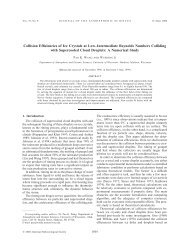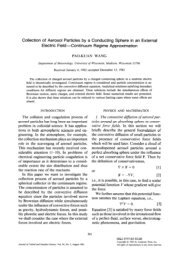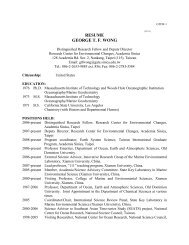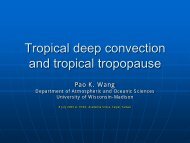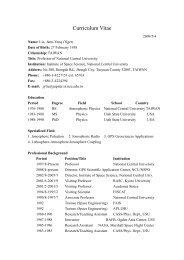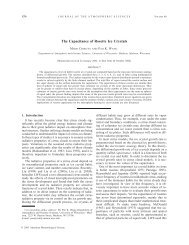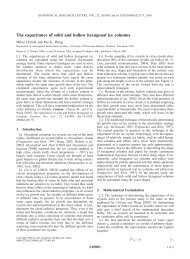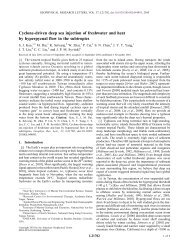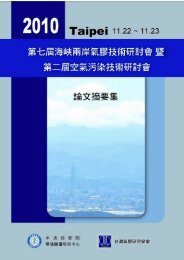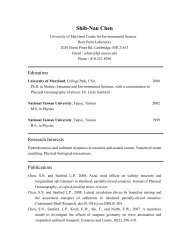Regional Tropical Precipitation Change ... - Academia Sinica
Regional Tropical Precipitation Change ... - Academia Sinica
Regional Tropical Precipitation Change ... - Academia Sinica
Create successful ePaper yourself
Turn your PDF publications into a flip-book with our unique Google optimized e-Paper software.
1SEPTEMBER 2006 C H O U E T A L . 4215<br />
vective regions, the gross moist stability M measures<br />
static stability of large-scale motion and the convective<br />
available potential energy (CAPE) measures static stability<br />
of convective system. The value of M is determined<br />
by the low-level moisture effect and the cloudtop<br />
effect (Yu et al. 1998). The greater low-level moisture<br />
enhances convection, and thus increases M q and<br />
decreases M. On the other hand, the stronger convection<br />
with higher convection height enhances M. This<br />
indicates a strong cancellation of the low-level moisture<br />
effect and the cloud-top effect, so a relatively constant<br />
M is found in convective regions. More detailed discussion<br />
of M can be found in Yu et al. (1998).<br />
The sum of p s and p q is associated with the<br />
M mechanism (CN04) if T is associated with free<br />
tropical warming and q in the atmospheric boundary<br />
layer (ABL) is also enhanced by the warming. The enhancement<br />
of the ABL moisture modifies the static stability<br />
of convective regions and produces negative M.<br />
The atmosphere in convective regions becomes easier<br />
to convert, so the convection and the associated precipitation<br />
are enhanced. The stronger convection can<br />
increase convection height and then produce positive<br />
M. Thus, M depends on convection height, which is<br />
sensitive to cumulus parameterization. Because of the<br />
dependence of M on convection height, the uncertainty<br />
of determining M is a potential cause for creating different<br />
tropical precipitation anomalies among climate<br />
models. A constant M s , which is also uniform in space,<br />
is usually used in a simplified climate model to avoid<br />
the uncertainty in determining convection height, such<br />
as in QTCM (CN04). The convection height is higher in<br />
deep convection regions, so M s is larger. Thus, the constant<br />
M s tends to reduce M and slightly overemphasize<br />
the dynamic feedback via · v 1 in deep convection regions,<br />
vice versa for shallower convective regions.<br />
When a constant M s is used, that is, p s 0, the<br />
term of p q becomes the main source for inducing<br />
the M mechanism, such as in CN04.<br />
The term v · q is associated with the upped-ante<br />
mechanism if q is associated with upper-level temperature<br />
anomalies in convective regions. A warm troposphere<br />
enhances low-level moisture in convective<br />
regions because of QE mediation, but not in nonconvective<br />
regions. This induces horizontal gradient of<br />
low-level moisture anomalies. The anomalous moisture<br />
gradient induces horizontal transport of dry air via the<br />
mean flow and suppresses convection over the margins<br />
of convective regions wherever there is inflow from<br />
nonconvective regions. The term v · T is relatively<br />
small compared to v · q in the Tropics, so the effect<br />
of v · T is usually neglected, such as in CN04.<br />
However, QE mediation implies an increase in lowlevel<br />
moist static energy, and there can be a temperature<br />
contribution to this in addition to that of moisture.<br />
The other terms of horizontal advection, v · T<br />
and v · q, are dynamical feedbacks associated<br />
with v. This horizontal transport of moist static energy<br />
also induces regional precipitation anomalies and is<br />
similar to that occurring in El Niño in Pacific decent<br />
regions (Su and Neelin 2002). This effect has been defined<br />
as anomaly wind mechanisms by Neelin and Su<br />
(2005).<br />
The surface net heat flux anomalies F s are balanced<br />
by ocean heat storage and heat transport. Ocean heat<br />
storage and transport can be roughly estimated from<br />
the spatial pattern of F s without knowing the ocean<br />
circulation. Ocean heat storage tends to have wider<br />
spatial patterns, while ocean heat transport divergence<br />
can create more local features. The net heat flux<br />
anomalies at TOA F t are associated with OLR and net<br />
solar radiation at TOA. Both longwave and solar radiation<br />
are strongly related to clouds, particularly in a<br />
regional scale, so F t can be treated as a cloud–radiative<br />
feedback. A part of F t that is associated with deep convection<br />
acts like modification of gross moist stability<br />
(Su and Neelin 2002). For instance, the TOA solar radiation<br />
associated with deep convection dominates F t<br />
in the QTCM simulations (Su and Neelin 2002). Thus,<br />
F t a · v 1 0,<br />
10<br />
where a is a positive value. Replacing F t in (3) with (10)<br />
modifies the factor M with the addition of a. In other<br />
words, the shortwave cooling in regions of anomalous<br />
rising motion acts like a modification of p h in p h.<br />
In the Tropics, however, a near cancellation between<br />
the net TOA solar radiation and OLR is found over<br />
regions dominated by deep convection (Kiehl 1994;<br />
Cess et al. 2001; Hartmann et al. 2001).<br />
A large-scale average of F t has very different balances<br />
than the regional variations discussed above. The<br />
average of the term on the left of (3) and the first four<br />
terms on the right is either close to zero over the global<br />
region or exhibits a very small exchange with midlatitudes<br />
if averaged over the Tropics. Then, balances<br />
among large-scale aspects of<br />
F s F t 0,<br />
11<br />
where [] is spatial average, are crucial. These set the<br />
large-scale T pattern through variations of longwave<br />
radiation and one can trace mechanisms for T to regional<br />
tropical precipitation anomalies that are initiated<br />
by QE mediation.<br />
Finally, we note that there are substantial technical<br />
challenges to computation of MSE budgets from standard<br />
GCM diagnostics. For instance, it has been known



